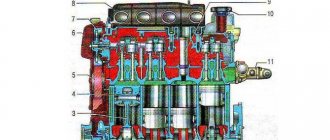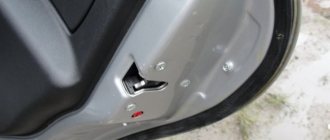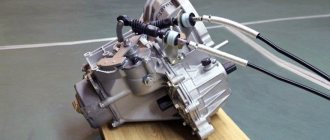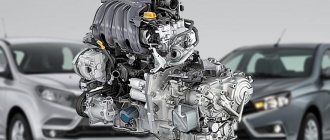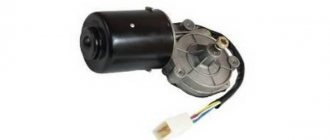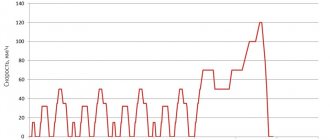About modern VAZ engines
The manufacturer offers a choice of two 8 valve engines :
- VAZ-11183-50 (82 hp) is a modified VAZ-2111 engine, as a result of which environmental performance has increased, the engine has become more reliable and less capricious. It also has the advantage of elasticity and traction. Disadvantages include periodic valve adjustments and noisy engine operation. If the timing belt breaks, the valve does not bend.
- VAZ-11186 (87 hp) is a modified VAZ-21114 engine, as a result of which it was possible to reduce noise and gasoline consumption. Environmental friendliness has improved and power has increased noticeably. Disadvantages: compared to the VAZ-11183, this engine has a shorter service life. When the timing belt breaks, the valves bend.
16 valve engines :
- VAZ-21126 (98 hp) is a continuation of the VAZ-21124 engine and is currently one of the most advanced domestic engines. Disadvantage: valve bends when the timing belt breaks.
- VAZ-21127 (106 hp) is a modified VAZ-21126 engine. In comparison, the engine has become more torquey at the bottom, the changes are minor, but noticeable. The disadvantages include bending of the valves when the timing belt breaks.
Possibilities for engine modification and tuning
As an option to increase engine power, it is possible to carry out chip tuning in order to remove restrictions on the environmental class. The overall percentage of power increase will not exceed 2-5%.
Replacing the camshaft. It is not economically feasible, just like installing a turbocharger. Replacing the camshaft and receiver will remove 100 hp from the engine. If you additionally modify the cylinder head channels, you can gain an additional 20 hp.
To carry out such modifications, it is first necessary to change the engine design from SOHC to DOHC. That is, it is necessary to replace the cylinder head with a 16 valve with two camshafts. Such a replacement will increase the possible power of the 8-valve engine to 120 hp. without significant impact on the overall engine life.
In fact, modification of the engine comes down to converting it into a 16-valve version with the possibility of further refinement and increased power.
New Lada: Adjusting headlights on a Lada Granta with your own hands - video and photos
Engine VAZ 21116/11186 1.6l. 87hp
In this article we’ll talk about the “Grant” engine 11186 or 21116, which replaced the 21114 engine from the VAZ 2114. Let's talk about the advantages and disadvantages compared to the previous generation.
Specifications
Start of production – 2011 to the present day. Appeared for the first time on Grant in the same 2011.
Cylinder block - cast iron
Power system – injector, e-gas (electronic gas pedal)
4 cylinders, 8 valves, in-line. Piston stroke – 75.6 mm; Cylinder diameter – 82mm. Engine capacity 11186/21116 –1.6l. Engine power 11186/21116 – 87 hp. /5100 rpm Torque - 140 Nm / 3800 rpm Fuel - AI95 Fuel consumption - city 8.6 l. | track 5.8 l. | funny 7.3 l/100 km
Description of engine 11186/21116
"Grant" engine power 87 hp. is a modified engine 21114 from Lada Samara. The difference between Grant's and its predecessor is the use of a Prioro-piston and Prioro cylinder block. The rest of the filling remains unchanged.
Lada Granta 21116 engine life, maintenance, pros and cons
The Lada Granta 21116 engine model under consideration differs from its predecessors in sufficient reliability and efficiency. If you take into account compliance with the operating and maintenance conditions (time frames for maintenance), you can significantly extend the service life of the unit.
Features of servicing the VAZ 21116 engine:
- The engine oil and oil filter are replaced every 15 thousand kilometers (recommended by the manufacturer);
- mandatory adjustment of valve clearances and replacement of the valve cover gasket;
- replacing spark plugs, air and fuel filters after 30 thousand kilometers;
- after a run of 90 thousand kilometers, they change the coolant, drive belts, high-voltage wires, etc.
Fuel consumption per 100 km, even when driving in city traffic (traffic jams, traffic lights), usually does not exceed 10 liters. By the way, the use of AI-95 fuel recommended by the manufacturer can reduce fuel consumption even further.
You can also note the normal start of the engine in cold weather, even after the car has been idle for a long time. Also a plus is a reduction in noise (minimal vibration) and an increase in the torque of the internal combustion engine.
The only drawback is a broken engine timing belt, which leads to bending of the valves (as a result, expensive repairs). Also, in some cases, the fragility of the pistons is noted (when they collide with the valves, they sometimes break and require replacement much earlier than their allotted time);
Malfunctions, causes, elimination
The first drawback of Lada Granta engines, as already mentioned, is the bending of the valves when the belt breaks. To avoid this malfunction, it is necessary to change it in time and visit service centers for maintenance. Then the valves will not bend, since the updated belt will last for another 100 thousand kilometers.
Young people are trying to tune the power units of cars produced by the Lada Granta plant. This includes increasing engine power. To do this, they do chip tuning, that is, they program the electronic brains of the engine, or install a turbocharger. All this leads to the rapid depletion of the engine’s vital reserves and affects its operation. A tuned engine loses 50 thousand kilometers, which it would have covered if it had been left aspirated. And that's the minimum.
Other problems are hidden in the malfunction of hydraulic valve lifters. This is also a common malfunction that car owners have to deal with. This can only be solved by installing new hydraulic pushers.
Forgetting to regularly replace filters leads to system contamination. Crumbs from used engine parts appear and travel through the oil system. It acts as an abrasive on the pistons and wears them out. The solution to this problem is to regularly replace the filter elements, especially for oil and fuel filters.
The knocking sound of the crankshaft main bearings is a concern for car owners. In this case, you need to make sure that the oil pressure in the engine is normal. Tighten the flywheel mounting bolts.
If everything is fine with the bolts and oil, then you may have to replace the crankshaft bearings or grind the journals, or reduce the clearance in the thrust bearing. As a last resort, replace the crankshaft.
The most common problems of internal combustion engines 11186
Malfunctions of the VAZ 11186 begin after 60,000 kilometers, if you do not visit the service center at 40 thousand. Knocks may appear in the VAZ engine. They indicate unadjusted valve clearances. If everything is fine with them, then pay attention to the connecting rod and main bearings of the crankshaft. They may need to be replaced.
If the speed in the VAZ engine fluctuates. The problem may lie in a malfunction of the throttle valve. It is necessary to check the functionality of the damper sensors. If they are not working properly, replace them with new ones.
If the thermostat breaks down, the VAZ 11186 engine begins to warm up slowly. When starting, it stalls - problems with the mass air flow sensor. If the mass air flow sensor is not repaired in time, the car may stall while driving somewhere on the highway.
There may be problems with the ignition unit or the standard electronic unit. The latter is unreliable. Therefore, if glitches appear in the control unit, it is better to replace it immediately.
Among the critical breakdowns, experienced mechanics identify problems with the pump and tension roller. If the roller jams, the teeth of the timing belt are cut off. The valve bends in almost every such case. The engine is immediately sent for overhaul. Therefore, it is better to avoid roller wedge and problems with the pump.
Design Features
Initially, engine 21129 retained the design of the basic version 21127:
- “tall” gray cylinder block, transferred from 11183, the surfaces of the liners are processed by honing;
- Cylinder head from modification 21124;
- gas distribution mechanism with phased injection with hydraulic compensation of thermal valve clearance;
- lightweight piston group from Federal Mogul;
- V-belt drive of timing camshafts with rounded teeth from Gates with a service life of 200,000 km;
- crankshaft with long radius crank from internal combustion engine 11183;
- fuel rail with medium-performance injectors from Bosch or Siemens;
- individual spark plug ignition coils without a high-voltage wire bundle;
- increased diameter of the damper on the flywheel;
- catalytic converter built into the exhaust tract - catalytic collector.
Engine
This is a standard 186 modified engine. Lightweight piston group. Previously, the valves on them could bend if the timing belt broke. But in the new Lada Granta on all engines the valves no longer bend - the pistons are plugless. These are not capricious motors, repairable, spare parts are inexpensive. But they do not have hydraulic compensators, so the valve clearances need to be adjusted (every 30,000 km).
A 5-speed manual transmission is installed, which has been used for many years. But the noise from the gearbox is much reduced, especially in 2nd gear. The engine has some advantages over 16 valves. In terms of the cost of a car with different engines, the difference is only 15,000 rubles.
Overall figures between 21116 and 11186
Both the engine with the index 21116 and the engine 11186 have the same performance in relation to:
- Economical.
- Pickup.
- Maintainability.
- Vibration and noise level.
- Lightweight connecting rod and piston group with new technologies.
Both engines have the same problems:
- With smooth turns.
- The presence of knocks and noises under the hood.
- In the area of the electronic control unit.
- Trouble due to valve burnout.
- Stopping a car due to a stalled engine.
- With a broken thermostat.
- Oil leaks from under the valves.
Both Lada Granta with engine 11186 and Priora with engine 21116 consume fuel:
- On city roads it is about 1 liter .
- On the highway up to 5.3 liters .
- With mixed travel up to 6.8 liters .
The engines do not have hydraulic compensators, so the valves need to be adjusted after 15,000 km. mileage _ And for ShPG it is necessary to exclude shock loads. Engines love only high-quality fuel, the reason is a high compression ratio and a tendency to detonation.
Tuning
Initially, the manufacturer builds additional potential into its engines in order to make any changes in future versions. However, the 11186 engine can be upgraded on its own. The following type of tuning is considered standard:
- camshaft - replacement of a standard part with a Nuzhdin 10.93 or Dynamics 108 camshaft;
- cylinder block - boring to 86 - 88 mm (pistons and connecting rods of appropriate sizes will be required);
- intake manifold - zero resistance filter, damper with a diameter of 54 mm, grinding of the internal surfaces of the channels;
- catcollector - replacement with a spider having a 4:2:1 scheme;
- Timing - installation of T-shaped lightweight valves;
- Cylinder head – head milling.
Maintenance
Guaranteed operation of the VAZ-11186 engine is ensured by following the manufacturer’s recommendations:
- operating modes;
- timing of maintenance.
Maintenance of the VAZ-11186 engine comes down to:
- Regular inspection of the power unit, as a result of which oil and coolant leaks can be detected. If such defects are identified, they must be eliminated;
- Regular replacement of engine oil - every 15,000 km. It is recommended to use motor oil from well-known manufacturers, purchasing it from trusted suppliers.
Maintenance
According to AvtoVAZ recommendations, the 11183 engine must be serviced according to the regulations:
| Maintenance object | Time (month) or mileage (10,000 km), whichever comes first |
| Timing drive | 36/ 1 |
| Battery | 12/2 |
| Valve clearance | 24/2 |
| Crankcase ventilation | 24/2 |
| Belts that drive attachments | 24/2 |
| Fuel line and tank cap | 24/2 |
| Engine oil | 12/1 |
| Oil filter | 12/1 |
| Air filter | 12 – 24/4 |
| Fuel filter | 48/4 |
| Heating/cooling circuits | 24/4 |
| coolant | 24/4 |
| Oxygen sensor | 10 |
| Spark plug | 12 – 24/2 |
| Exhaust manifold | 12/1 |
By default, the cooling system has a volume of 7.8 liters. Red Felix Carbox 40 antifreeze is usually poured on the conveyor. Replacement is made with any coolant, taking into account the temperature range of 85 degrees. Since the internal combustion engine device is quite simple, the maintenance operation can be performed on your own.
